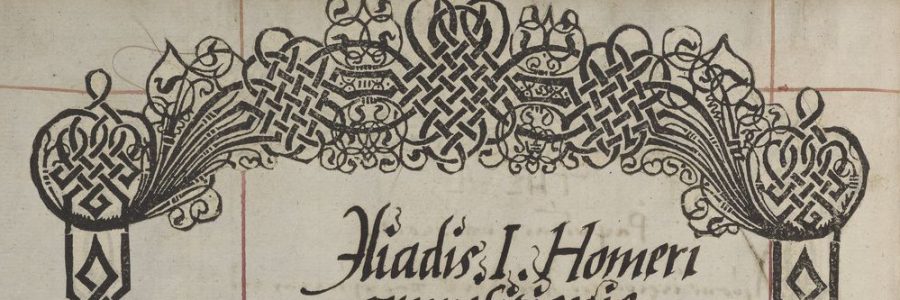
The Polonsky Foundation Greek Manuscripts Project: When a Greek Manuscript is … German
Not all Greek manuscripts are Greek. It may sound strange, but you only need to remember that many Greek manuscripts kept in libraries all over the world were not made in Greece, southern Italy or Greek-speaking areas of the Levant. Often these are late-medieval or early modern manuscripts. Under the pressure of the Ottoman Turks from the East, many Byzantine scholars and copyists migrated to the West and settled, especially in intellectual centres such as Venice and Paris. Some Greeks continued their journey to England, like Georgios Hermonymos. These copyists continued to copy and produce books, bringing their skills to the West, but equally, some Greek manuscripts were copied in Western Europe by scribes who were not native speakers of the language.
This is the case of two unusual Greek manuscripts from Christ’s College Library that well represent the value of the collaboration inherent in the Polonsky Foundation Greek Manuscripts project between Cambridge University Library and Heidelberg University Library. Copied in the mid-sixteenth century, when printing was already widespread, the two manuscripts Rouse MSS 358 and 359 are massive paper volumes bound in parchment. Like almost all the Greek manuscripts in the college library, the two manuscripts were donated to Christ’s College in 1940 by W.H.D. Rouse. He was a fellow of the College and headmaster of the Perse School in Cambridge. He is best known for using and promoting the “Direct Method” of teaching Latin and Greek (where instruction is given exclusively in the language being learned) and for being a founding editor of the Loeb Classical Library along with T. E. Page and E. Capps.

The two volumes stand out for their eccentricity. Unlike the other Rouse Greek manuscripts, which he bought on his travels in Greece, these two come from Germany, probably from the city of Augsburg. They are the work of an obscure sixteenth-century scholar-librarian, Carolus Stephanus, who left his signature throughout the manuscripts.
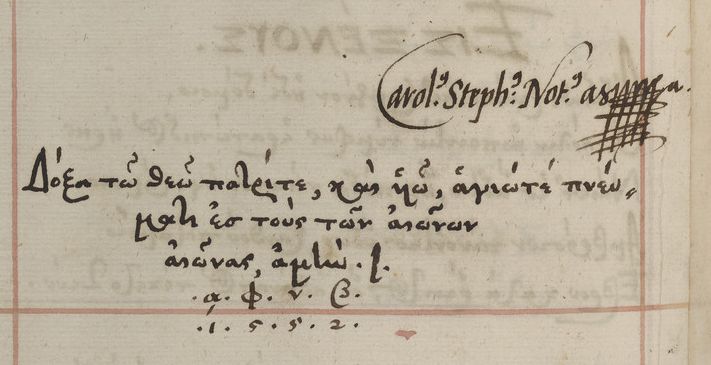
Carolus Stephanus claims to have copied the manuscripts for personal study. Little is known about him: he served as the librarian of Johann Jakob Fugger (1516-1575), one of the most prolific book collectors of the sixteenth century. Copied between the 1550s and 1590s, MS Rouse 358 contains the Iliad, the Odyssey, the Battle of the Frogs and Mice (a parodic epic poem attributed to Homer), and Homeric hymns while MS Rouse 359 contains works by Sophocles, Pindar, Hesiod and Aeschylus, accompanied by numerous extracts from various encyclopaedias and commentaries. Another Greek manuscript copied by Stephanus survives: a Book of Psalms in Greek (Karlsruhe, Badische Landesbibliothek, Codex 431).
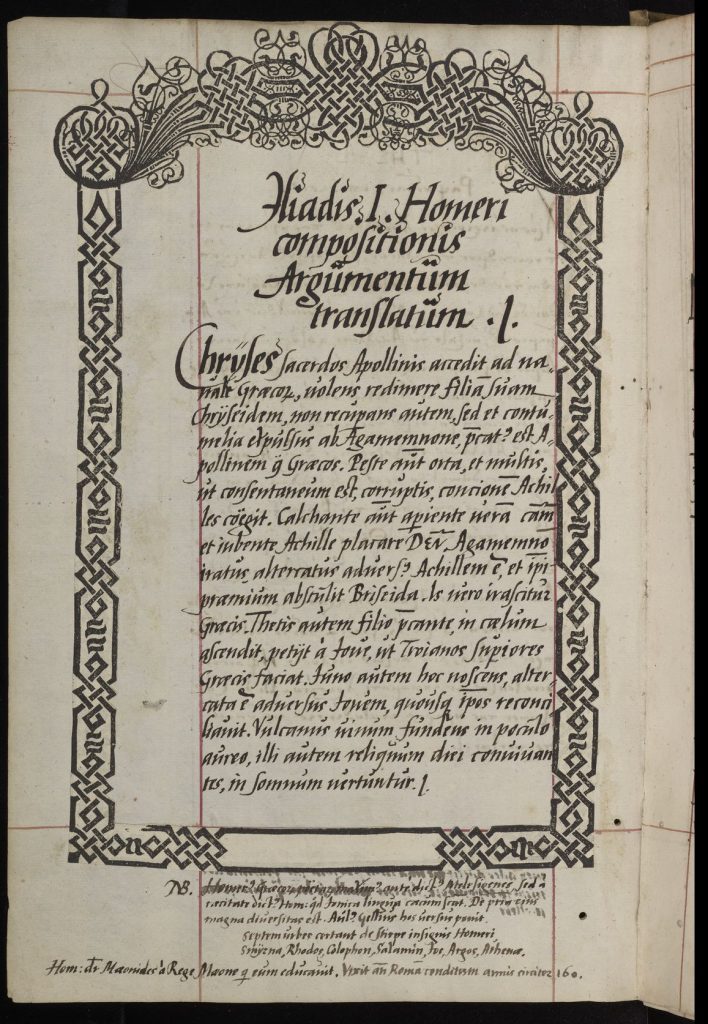
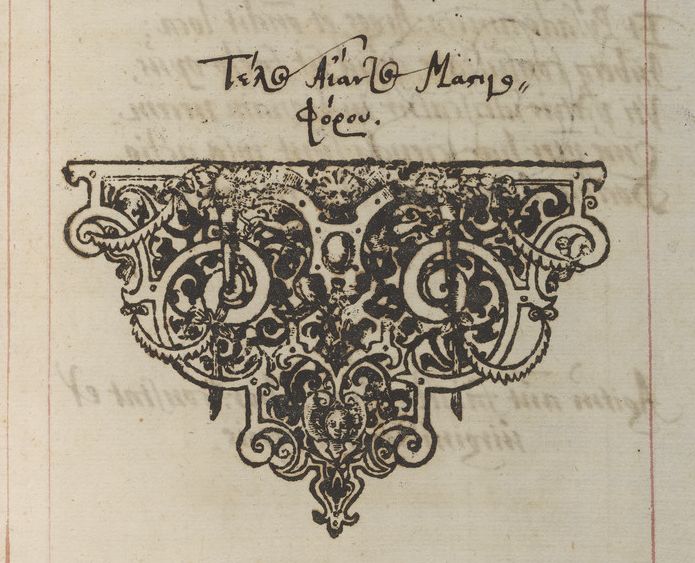
One peculiarity of the Rouse manuscripts are the printed frames glued around the Latin hypotheses to the texts, and other stencilled decorations to fill the empty spaces.
The first volume, in particular, has a beautiful portrait, labelled as a true portrait of Homer. Though the very existence of the poet has been a matter of discussion for centuries, it seems that Carolus Stephanus had no doubts about the face of the blind poet.
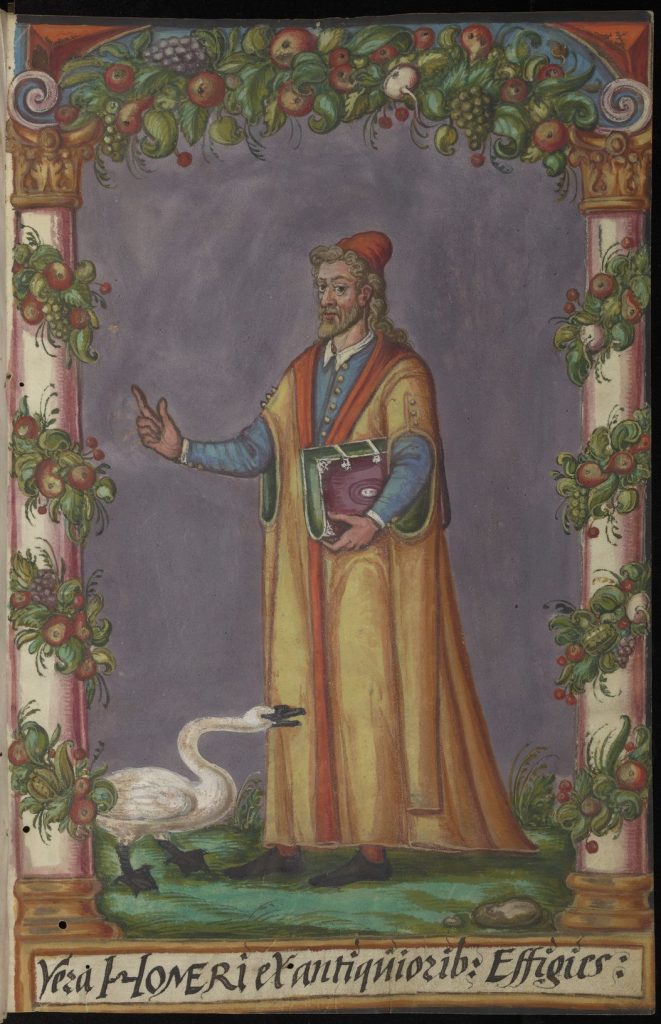
The manuscripts are not limited to the Greek verses of the various ancient poets. Carolus also added texts in Latin, and in German. Here the value of the international collaboration of the Polonsky Foundation project comes into play.
In the manuscript Rouse 358, the Iliad is followed by two epitaphs to Homer and a short text in German. The text is immediately visually distinct, being written in a different script from that used for Latin (and of course Greek).
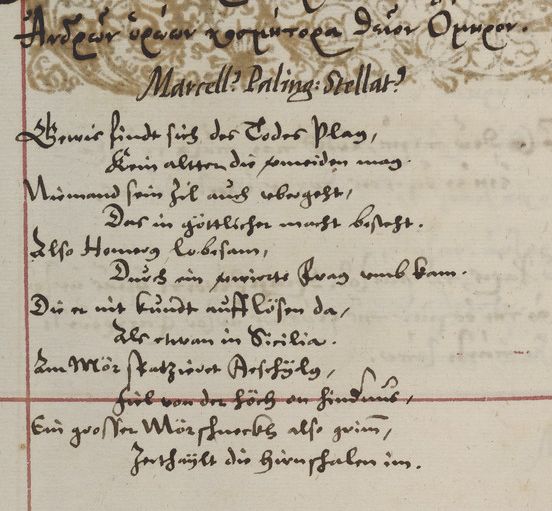
These lines are difficult to read for those who are not used to deciphering German handwriting or are not familiar with the language. There are, however, two clues to identify the text: first, it speaks of Homer and the name Marcellus Palingenius Stellatus is given as the author of this text. Stellatus (aka Marcello Stellato) was a sixteenth-century Italian poet who is known, if at all, for his Latin philosophical poem about the signs of the zodiac, Zodiacus Vitae.
It was at this point that our Greek cataloguer in Cambridge called upon assistance from Heidelberg. Fortunately, Dr Karin Zimmermann, the director of the Heidelberg section of the Polonsky Foundation Greek Manuscripts project, is a specialist in German manuscripts and the script posed little challenge to her. Dr Zimmermann may be perhaps the first scholar in centuries to read and transcribe the text in MS Rouse 358:
Gewis findt sich des Todes Plag,
Kein Altten die vermeiden mag.
Niemand sein Zil auch ubergeht,
Das in göttlicher macht besteht.
Also Homerus lobesam,
Durch ein verwierte Frag umb kam.
Die er nit kundt auff lösen da,
Als etwan in Sicilia.
Am Mör spatzieret Aeschylus,
Fiel von der höch on hindernus
Ein grosser Mörschneckh also grimm,
Zerthaylt die hirnschalen im.
Certain is the threat of death
No old man can escape him
No one draws out his destination (= death)
That consists of divine power
Also the laudable Homer
Died due to a bewildered question
He could not answer.
In Sicily for example
Aeschylus was walking along the shore
As from heaven above unobstructed
A big tortoise (literally: sea snail) fierce
Was splitting his skull.
It is a poem about the inescapability of death, with the examples of Homer and Aeschylus. Legend has it that Aeschylus died in Sicily because an eagle dropped a turtle on his hairless head, mistaking it for a rock. One of the Vitae Homeri reports that Homer died because he could not solve a riddle posed by some fishermen. Homer asked what they had caught, and they answered: “We left whatever we caught and carry whatever we didn’t”. According to Plutarch, the solution was lice!
With the text deciphered, it was possible to identify that these lines are actually verses from the Zodiacus Vitae by Marcellus Palingenius Stellatus (book vii, lines 336-341):
Certa dies leti est cunctis, discrimina nulla
Aetatis; nec fas vivendo excedere metas,
Praescripsit tetrici quas cuique potentia fusi.
Sic periit scirpo agni laudator Achillis.
Sic olim, dum Trinacriis spatiatur in oris
Aeschylus, occubuit volido testudinis ictu.
The verse in MS Rouse 358 are copied from the German translation by Johann Spreng. Slight differences between the manuscript and the text of the 1564 edition (ff. 172v-173r) available online led to the conclusion that in all likelihood the text was copied from Spreng’s revised translation of 1599 (ff. 190v-r). The manuscript was copied by Carolus Stephanus in 1552, but now we can add that some texts were added to the manuscript fifty or more years later.
Late medieval and early modern Greek manuscripts are full of surprises, unexpected texts and unusual origins. In this case, thanks to Dr Zimmermann, some detective work and a collaboration like the one between Cambridge and Heidelberg within the Polonsky Foundation Greek Manuscripts project, we can add unexpected chapters to the history of the collections of Greek and “Greekish” manuscripts in Cambridge.
By Dr Matteo Di Franco, Cambridge cataloguer on the Polonsky Foundation Greek Manuscripts project.
